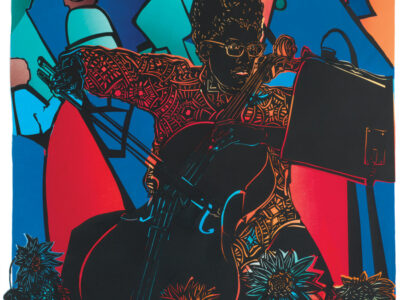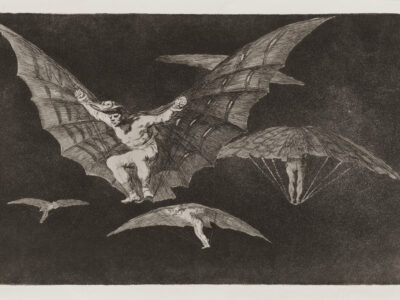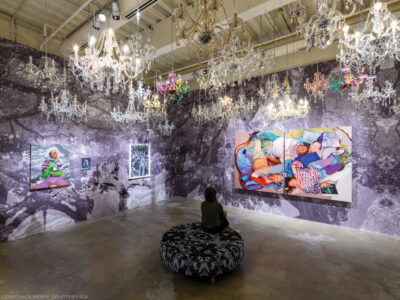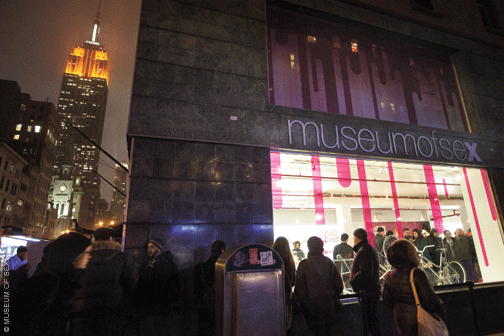
By the time Daniel Gluck W’91 GFA’92 was a junior, he was simultaneously on the path to serial entrepreneurship and a degree from the Graduate School of Fine Arts. In other words, he was the Wharton student with paint on his pants. He discovered his true calling during an entrepreneurial-management class taught by Ed Moldt, the former Wharton professor and managing director of the Sol C. Snider Entrepreneurial Center.
“I remember that day,” says Gluck. “A weight lifted off my chest when I realized I wanted to be him.”
The fine-arts degree, which required Gluck to stay at Penn for another year, was more along the lines of an elective. He wanted to learn the mechanics of painting.
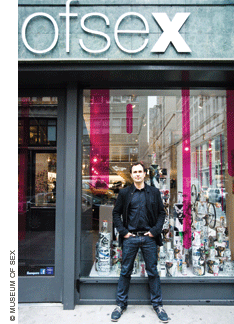
As frequently happens in hindsight, both degrees turned out to predict the unpredictable place where he sits today: his office in Manhattan’s Flat Iron district at the Museum of Sex (MoSex), the for-profit museum he founded in 2002. Gluck has created a job for himself that combines art, design, scholarship, and serial entrepreneurship.
MoSex’s stated mission is to explore “the history, evolution and cultural significance of human sexuality.” During the past decade its exhibitions have looked at sex through a range of filters, including social history (such as the history of burlesque) and the fine arts (erotic imagery of Japanese art in the Edo Period). But there’s more to it than that. Developing brand extensions such as Play!, a full-service restaurant opening on the museum’s ground floor next month, not to mention various MoSex product lines, requires Gluck to collaborate with both artists and entrepreneurs.
“The two have similar mentalities and dispositions,” he says. “People who create stuff have self-initiative, and entrepreneurs have to be creative.” He envisions MoSex as a multilayered company to rival Madame Tussaud’s expanding Wax Museum empire—at least in reach and revenues.
When Gluck graduated from Penn he was already deep into a business venture: Franklin Computing, a software company he started as a sophomore with a few classmates. At the same time, a friend from art school introduced him to the work of Camille Paglia, the social critic and professor at the University of the Arts whose newspaper and magazine columns and controversial book, Sexual Personae, became a major source of inspiration. By 1998, after starting a string of businesses, he found himself at a bar on the Lower East Side, brainstorming with friends about what to do with a building he’d bought with a group of investors at 27th Street and Fifth Avenue.
At first the idea for a museum about sex seemed a little absurd and a lot at odds with the city’s recent moves to discourage the development of sex-oriented businesses. But after doing some research, Gluck decided he had no choice but to open a venue that would energize the public in the same way Paglia’s writing had made him reconsider sex and art history.
“I couldn’t believe there wasn’t anything in the world like it already,” he says. “This seemed like such a large gap in the cultural landscape.”
In business and branding, sex can be a liability as well as a boon. New York’s Board of Regents refused to charter the venture as a non-profit. They declared the pairing of sex and museum unseemly—so Gluck opened it as a for-profit. He brought in academics and New York’s cultural intelligentsia—the corporal antitheses of Larry Flynt—to help telegraph his non-salacious mission.
The first person he reached out to was Paglia, who signed on as an advisor. So did writer and critic Luc Sante and historian Mike Wallace. Today the museum’s advisory board of 18 contains 11 PhDs, and its corporate bylaws prohibit financial backing from anyone in the adult-entertainment industry.
The underdog scenario with the Board of Regents was great for business, as was a requisite spanking by the Catholic League. Before the museum opened, the latter declared it a “museum of smut” and charged that it was “run by pornographers.” Curiosity seekers made the inaugural exhibition, NYC Sex: How New York Transformed Sex in America, a hit. Since then, Gluck says, growth has been slow and steady, with a 15 percent uptick in traffic each year. The museum broke even operationally after the first year and embarked on a large growth curve in 2010, doubling the size of its store and adding gallery space and a small café.
Since the very beginning, one thing has been unquestioned: working with the best designers available. “With this subject matter, design is essential,” says Gluck, “because peoples’ minds tend to go into the gutter.”
Michael Beirut, a partner at the legendary design consultancy Pentagram, created the brand’s clean, modern graphic identity. Gluck recently hired Daniel Basiletti, longtime product manager and right-hand man at Moss Gallery, the iconic high-end design shop and gallery in SoHo that recently closed after nearly two decades, to head up retail and product development. The space itself is bright and open—more Dwell than Penthouse.
“If we designed it the way Larry Flynt would’ve designed it,” says Gluck, “we wouldn’t still be around.”
He is now working on the many brand extensions orbiting the MoSex nucleus, including a potential location in Las Vegas and a possible boutique hotel in New York. Gluck’s team, with the help of Lee Silver (a professor of molecular biology and public policy at Princeton), recently developed the MoSex Sexual Personality Test, which purports to use a “new form of data analysis developed by genetic researchers to uncover new and meaningful insight into your sexual personality.” They’re turning it into an app for people to interact with each other. Play! will be a testing ground for new products melding sex and food. Also on deck is a line of sexual vitamins and supplements.
“We want to build the Kiehl’s of sex products,” says Gluck, referring to the high-end cosmetics retailer. For a self-described disciple of Ed Moldt, build is the operative verb. “This really is the dream situation,” he says. “A business that’s a thousand businesses.”
—Caroline Tiger C’96


